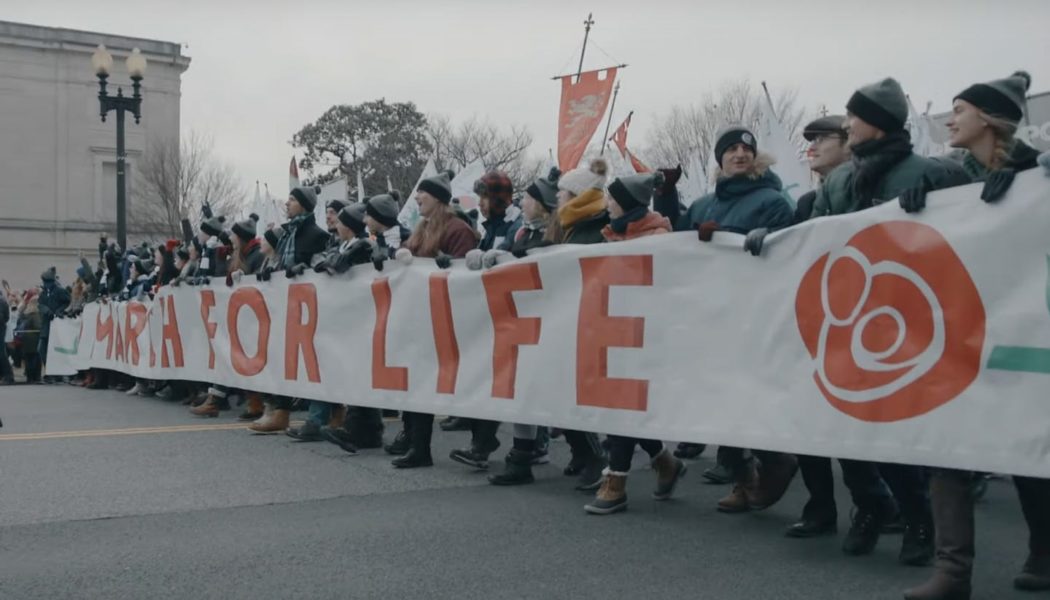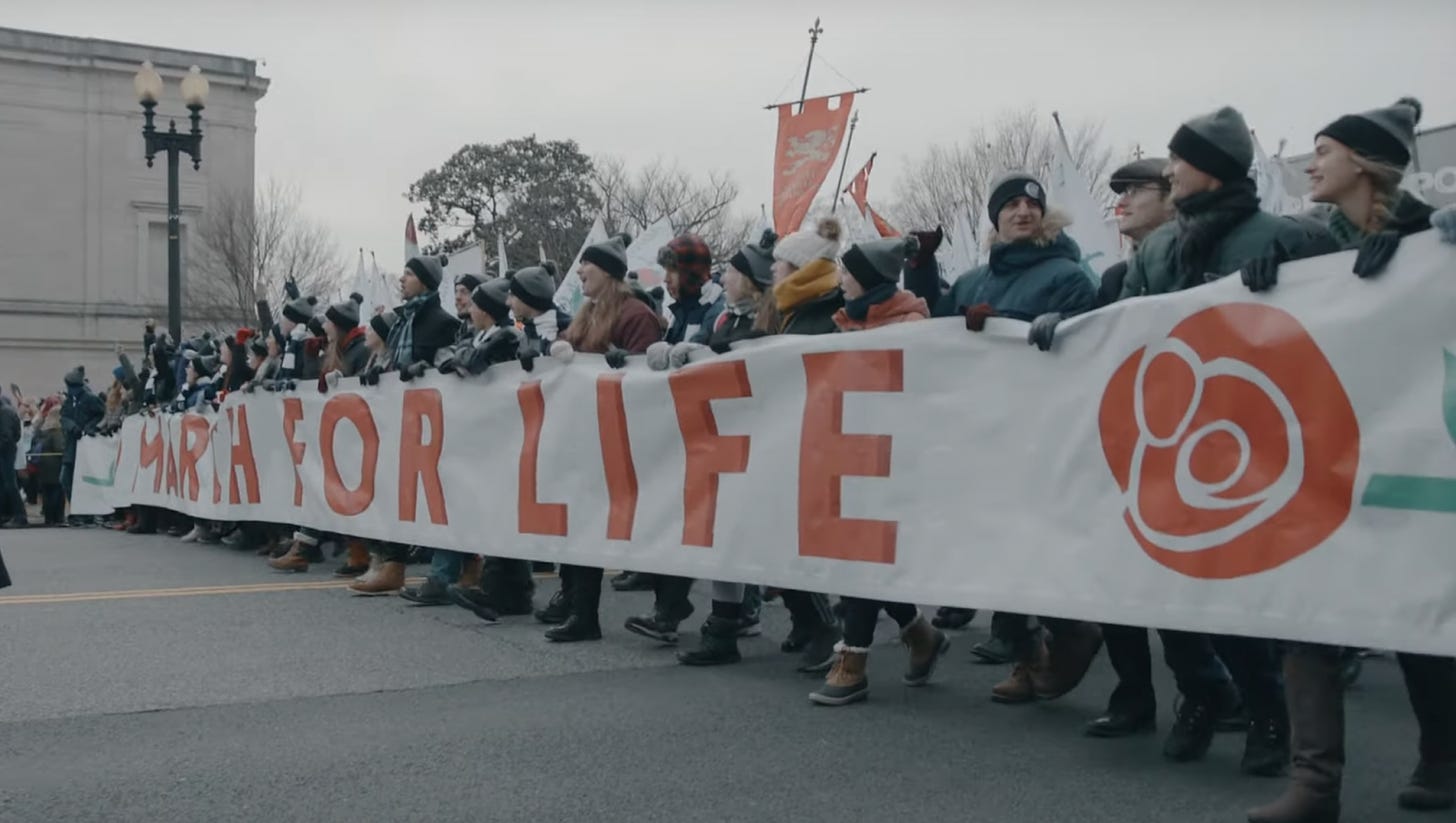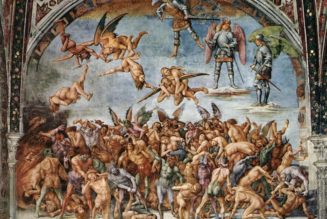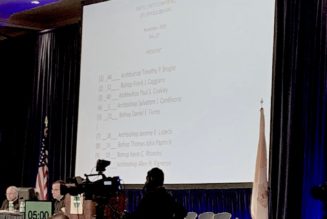Happy Friday friends,
It is snowing here in DC, at least in the part of it visible from my office window. The temperature is meant to hold at around or just below freezing, though the wind off the Chesapeake means it will feel considerably colder than that for anyone out and around.
I am, of course, giving you the weather forecast because today, Jan. 19, is the March for Life here in Washington, and a great many of us will either be out there ourselves over the course of the day or have friends and family who will be.
The event isn’t quite the same as it was before the Dobbs decision returned the issue of abortion to the individual states, how could it be? The day of the march itself is scheduled to coincide as closely as possible with the anniversary of Roe v. Wade, which is now dead law.
As such, the focus of some pro-life activism has shifted away from the Supreme Court, towards Congress, where one party remains committed, with fanatical religious fervor, to enshrining abortion in federal law, and to the states.
In the wake of Dobbs, state capital marches have sprung up and a little of the steam has necessarily gone out of the DC event. The annual Mass for Life no longer takes place in the Capital One Arena, for example — a result of soaring insurance costs and dioceses scaling back their contributions to focus on local events.
But, I would argue, the Washington march matters now as much as ever. It doesn’t really matter what the ostensible political aim is — a Supreme Court decision, an act of Congress, whatever. The most important part of the march, I think, is the witness of the people who come to the people they meet.
Abortion is no less a live political issue now than pre-Dobbs, of course. If anything, it has become more charged. And, in an era of hyper-partisanship, those who stand for life are standing against the overwhelming weight of media coverage which insists that the cause of life is the cause of a lunatic fringe; an angry, irrational, embittered minority looking to foist a radical crypto-religious agenda on the country.
This is what we are marching against, really. And what we are marching for is the truth. The truth that every single human life has value, has dignity, and is deserving of love.
That can be hard to keep in mind in the teeth of the kind of pro-abortion counter-protests which have become normal, and which are characterized by at times intense aggression and furious anger.
But the witness to life is a witness to love — of the unborn, their mothers, the families and communities from which they come, and even those who would malign us for that witness.
As a counter sign to the kind of hate we often can encounter, our witness to life and love must, it seems to me, be joyful to be effective. It is that joy which will speak loudest, though perhaps only subliminally, to the people who will see it passing them on the streets of Washington today.
It takes grace, and faith, to believe that love can conquer hate, that life can win out over death. And communicating that grace and faith needs a special kind of witness — the witness of families, of youth, of people from all corners of a continent, coming together in a single place to march for a single imperative: to love our neighbor.
Anyone who thinks that is a simple task, or one that comes easily, should take a walk in downtown DC today. Because that’s what the March for Life does: it changes hearts and minds, one at a time. With love.
Now, here’s the news.
The News
Earlier this month, the body of Fr. Josiah K’Okal, IMC, was found hanging from a tree in a wooded area in Guara, Monagas state, Venezuela. It was quickly ruled a suicide.
But, in some exclusive reporting for The Pillar this week, Edgar Beltrán looked into Fr. K’Okal’s life, ministry, and the circumstances of his sudden death. The conclusion it’s almost impossible not to draw is that K’Okal didn’t kill himself, but someone wanted it to look that way.
The Kenyan priest, a member of the Missionaries of the Consolata, had been one of the loudest voices in defense of the human rights of indigenous communities in the region, especially the Waraos of the Delta Amacuro.
K’Okal became a spokesperson for the abuses and hardships suffered by the Waraos, denouncing the trafficking and mass sterilization of indigenous women, along with the overcrowding in refugee camps on the Brazilian side of the border.
That made him a lot of enemies.
And the circumstances in which his body was discovered do not, I think it is fair to say, support the notion he killed himself. What we are looking at here is, in all likelihood, a priest who was murdered for his pastoral work and his solidarity with an oppressed people.
Because of the politics of the Maduro regime in Venezuela, though, you can’t read about it in that country. And because of the current difficulties the Holy See has with that regime, K’Okal’s story isn’t one likely to be taken up by Rome for international attention.
But Fr. K’Okal’s life and death and ministry matter. And his story deserves to be told.
—
The president of Poland’s bishops’ conference entered a highly charged and complex political dispute Wednesday, with an offer to mediate on behalf of two jailed politicians.
The situation is… complicated, and Gądecki’s decision to insert himself into it is… bold.
Kamiński and Wąsik’s case has generated massive media interest in Poland, exposed divisions in the judiciary and pitted the new coalition government against the country’s president.
The two politicians are currently on hunger strike after being detained following the cancellation of a presidential pardon by the country’s supreme court — a decision which itself has caused something of a judicial crisis.
The men were originally sentenced to three years in prison in 2015 for abuse of office, ironically as the head and deputy head of Poland’s Central Anticorruption Bureau.
While their appeal process was underway, President Andrzej Duda pardoned them both and they went on to serve in the Law and Justice government which was in power until last year. But the legal process rumbled on, and in June last year the Supreme Court ruled the pardons unlawful, and an election turfed Law and Justice from Power in October, though Duda remains president.
When a warrant was issued for their arrest in December, they even sought sanctuary in the presidential residence, where they were finally arrested.
That’s just a brief thumbnail of what is a frankly incredible narrative dividing Poland down the middle.
So what would possess an archbishop to grab that third rail of an issue?
—
An Argentine see fell vacant again Wednesday after a second bishop in a row resigned before he could be installed as head of the diocese.
Francis had nominated Larrazábal on the day that he accepted the resignation of Bishop José María Baliña, 22 days after the pope had named him as the incoming head of the diocese.
The Vatican has not provided reasons for the resignations of either bishop. So what the heck is going on in Mar del Plata?
You can read our full report here.
—
The Syro-Malabar Church is facing another crunch weekend, and the first real test for its newly elected leader, Major Archbishop Raphael Thattil.
Previous letters on the same subject have been publicly burned by local Catholics, priests and laity. So we will see what happens. Pray for the unity of the Church.
—
And finally, Pope Francis issued two new apostolic letters Tuesday, amending the financial regulations for Vatican curial offices and for the Vatican city state.
The pope set a new threshold for acts of “extraordinary administration,” which require approval, and amended policies Francis set in 2020 governing external contracting and purchasing orders by Vatican bodies and institutions.
You can read our coverage of the details, but the chief takeaways here, as I see them, are twofold:
1. The Holy See is continuing to learn lessons in the fallout of the Vatican financial scandal and trial. Several of the changes would have prevented the Secretariat of State from doing business with the key players in the scandal, had they been in force in 2018, and they appear like obvious responses to those events.
2. APSA, the Vatican’s sovereign asset manager, central purchasing hub and paymaster continues to see its authority and remit eroded — rapidly. At this point, I wonder what will be left for it to do, apart from act as chief administrator of parts of the Vatican’s real estate portfolio.
You can get a deep dive on what’s changed in Vatican law, and why it matters, right here.
Border watch
Spare a thought this week, if you can, for Arnold Schwarzenegger.
The former Mr. Universe, box office legend, and governor of California was nabbed by customs as he flew into the German city of Münich on Wednesday. His crime? Failure to declare a wristwatch in his luggage.
“Vee haff initiated criminal prozeedings accordink to tax law,” a spokesman for the central customs office in Münich told Bild newspaper. “Zee watch should haff been declart zince it eez an import.”
“If zee goots remain in the EU, you haff to declare zem through customz. Zis applies to everyone, whether zer name is Schwarzenegger or Müller, Meier, Huber.”
Apparently, Schwarzenegger was subjected to a “random” search of his bags when the watch was discovered. The watch in question, the personal property of Mr. Schwarzenegger, is apparently a custom-made Audemars Piguet, which the watch company gave him as a gift.
AP, for those of you who don’t know, is one of the three Swiss manufacturers referred to as the “Holy Trinity” by watch nerds, along with Vacheron-Constantin and Patek Philippe. It’s the super-rarefied strata of Swiss horology to which Rolex constantly aspires but can never ascend.
The watch was, as it happens, intended to be left in the EU, and not travel back home with Arnie. He donated, or intended to donate, the timepiece as an auction prize for his environmental charity’s gala in his birth nation of Austria, held last night.
Instead, he was fined the declared value of the watch, which Schwarzenegger said was €26,000, plus €4,000 in tax and a €5,000 penalty.
You might think this was punishment enough, but this being Germany it all got a bit “extra,” as the kids say. The governator was interrogated for fully three-and-a-half hours, and made to declare his total assets, the balances of all his bank accounts, and the name of his current romantic partner.
From there, things got even more… unheimlich.
German law, apparently, doesn’t allow you to settle your debts to society with a Visa card, and Schwarzenegger was required to post at least half his total bill in cash.
Needless to say, the airport ATM wouldn’t dispense seventeen-and-a-half grand, so he was frogmarched to a bank to make the withdrawal, then — cash in hand — brought back to the airport and harassed further, before being released, finally.
Schwarzenegger made his own statement on the affair, saying he’d tried to explain the watch was a charitable donation destined for Austria, it even said so on the box, but to no avail.

I’m not an expert in EU tax law. So, I suppose, it is possible the last action hero was bang to rights for trying to bring his own watch into the EU with the intention of giving it to charity.
Indeed, knowing the Germans, the entire idea of personal philanthropy, instead of state-ordered “charitable” taxation and distribution, might be seen as criminally suspect there.
I can certainly believe that it made no difference to them that the watch’s final destination was Austria. Germans have historically struggled with the concept that neighboring countries aren’t actually part of Germany.
I’d have thought, though, given Arnold’s personal stature, he might have told the officious little Fritz to verpiss dich, or, given his status as an American citizen and former governor, at least screamed for his ambassador, but I suppose zey hat veys of making him talk.
Still and all, I think Schwarzenegger may have pulled a fast one on them.
I’ve not been able to pin down either exact model of the watch or how it was customized to honor the great man. But looking at the photo of his interrogation, Arnold seems to be wearing an AP Royal Oak Offshore in rose gold, ref. 264700OR, a discontinued model with a last reported retail price of $76,800, now trading at more than $100,000 on the secondary market.
Now, let’s assume Arnold wasn’t donating this exact watch. He’d probably still be donating one of at least equivalent value, especially when you consider it was customized for him by AP — making it a piece unique, as they say in the watch trade.
All in, getting away with a declared value of under $30k seems like a steal to me, and in the fine tradition of American heroes pulling a fast one on their German captors.
Schwarzenegger is, by the way, something of a legendary watch guy and the biggest and best manufacturers, like AP, have long lined up to supply him with special issue pieces for his films.
In the 1999 action-apocalypse flick “End of Days” (not his finest work), AP kitted Arnold out with another Royal Oak, a limited edition black PVD number which has become a much sought after collectors’ item.
For myself, while I’m definitely an Arnie fan, AP isn’t really my jam, and I’ve never been into the Royal Oak line — they are technically great watches, don’t get me wrong, but the aesthetics of the things just don’t do it for me.
If you want a Schwarzenegger watch, I’d recommend going back to his early work and get the Seiko H558-5009, now known in watch circles simply as “the Arnie,” which he wore in the 1985 classic “Commando” as well as the 1987 masterpiece “Predator.”
You can have one of these new, under its new reference number, for around $300. It’s a lot of watch, and I am not sure I could pull it off, but it’s what real Austrian-American heroes wear.
See you next week,
Ed. Condon
Editor
The Pillar
Comments 35
Services Marketplace – Listings, Bookings & Reviews











